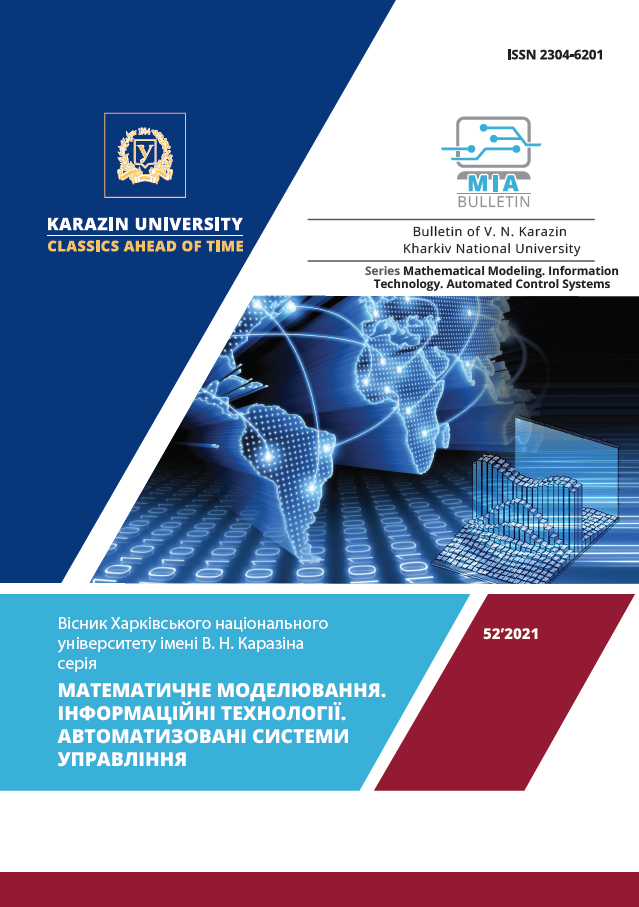Analysis of "big data" and mathematical modeling of the covid-19 epidemic in Europe
Abstract
The regularities of the dynamics of the covid-19 pandemic in Ukraine and other European countries are studied by using the methods of analyzing "big data" in the form of time series and related information from open online sources. Statistical analysis of smoothed curves of new cases I (t), dead D (t), recovered R (t) and other time series has shown different types of dynamics: wave (i), quasi-wave with time shift (ii), stepwise (iii), with abnormally high or low amplitudes of local oscillations. The appropriate similarity trees have been constructed by using the nearest neighbor method. It is shown that the countries with different types of dynamics (i, ii, iii) are located in separate branches of the trees. The stability of zero and nonzero stationary points have been investigated on the basis of the popular mathematical model SIRS. The solutions of the linearized system have been obtained and the influence of the model parameters on the eigenvalues of the system matrix has been investigated. The presence of different types of dynamics is shown: with three negative real (a), one positive real (b), one real and a pair of complex conjugate(c) eigenvalues. The phase portraits have been constructed and the connection of the types of time series (i, ii, iii) and solutions (a, b, c) of the SIRS equations is shown. The obtained results allow us to estimate the dynamic behavior of the system, its stability or instability with the possibility of chaotic dynamics on the basis of the analysis of time series on any current day.
Downloads
References
/References
Worldometer. COVID Live Update [Електронний ресурс https://www.worldometers.info/coronavirus/]
Coronavirus Pandemic. Statistics and Research [Електронний ресурс https://ourworldindata.org/coronavirus]
N. Kizilova, Methods of "big data" analysis. Methodical recommendations on the course "Applied problems of big data analysis" for students of the specialty "Applied Mathematics". V.N. Karazin Kharkov National University, 2021, 96 p. (in Ukrainian)
A. Zakharova, N. Kizilova, “Study on correlations of disease dynamics on COVID-19 with some socio-economic factors”, Bulletin of Kharkiv National University, series "Mathematical modeling. Information Technology. Automated control systems", 2020, Vol. 47, P.49-56. https://doi.org/10.26565/2304-6201-2020-48-04
K. Voloshyna, N. Kizilova, P. Kiporenko, “Investigation of the dynamics of four waves covid-19 in European countries”, Bulletin of Kharkiv National University, series "Mathematical modeling. Information Technology. Automated control systems", 2021, Vol. 51, P.
V. Kostetzka, N. Kizilova, “ Mathematical modeling of the dynamics of the COVID-19 pandemic”, Bulletin of Kharkiv National University, series "Mathematical modeling. Information Technology. Automated control systems", 2020, Vol. 48, P.65-71. https://doi.org/10.26565/2304-6201-2020-48-06
Computational Modeling and Data Analysis in COVID-19 Research. Ed. by Ch.R.Panigrahi, B. Pati, M. Rath, R. Buyya. CRC Press. 2021.
D. Aldila, S.H.A. Khoshnaw, E. Safitri, et al. “A mathematical study on the spread of COVID-19 considering social distancing and rapid assessment: The case of Jakarta, Indonesia”, Chaos, Solitons and Fractals. 2020. Vol. 139, 110042. https://doi.org/10.1016/j.chaos.2020.110042
J. Sun, “Forecasting COVID-19 pandemic in Alberta, Canada using modifiedARIMA model”, Computer Methods and Programs in Biomedicine. 2021. Vol. 22, 100029. https://doi.org/10.1016/j.cmpbup.2021.100029
N. James, M. Menzies, “Trends in COVID-19 prevalence and mortality: A year in review”, Physica D. 2021. Vol. 425, 132968. https://doi.org/10.1016/j.physd.2021.132968
Worldometer. COVID Live Update [Електронний ресурс https://www.worldometers.info/coronavirus/]
Coronavirus Pandemic. Statistics and Research [Електронний ресурс https://ourworldindata.org/coronavirus]
Кізілова Н.М. Методи аналізу «великих даних». Методичні рекомендації з курсу «Прикладні задачі аналізу великих даних» для студентів спеціальності «Прикладна математика». Харків: ХНУ ім. В.Н. Каразіна. 2021. – 96 c.
Захарова А.А., Кізілова Н.М. Дослідження кореляцій динаміки захворювання на COVID-19 з деякими соціально-економічними факторами. Вісник Харківського національного університету серія «Математичне моделювання. Інформаційні технології. Автоматизовані системи управління». 2020. Вип. 47. С.49-56. https://doi.org/10.26565/2304-6201-2020-48-04
Волошина К.І., Кізілова Н.М., Кіпоренко П.В. Дослідження динаміки чотирьох хвиль covid-19 в країнах Європи. Вісник Харківського національного університету серія «Математичне моделювання. Інформаційні технології. Автоматизовані системи управління». 2021. Вип. 51. С.
Костецька В.В., Кізілова Н.М. Математичне моделювання динаміки пандемії COVID-19. Вісник Харківського національного університету серія «Математичне моделювання. Інформаційні технології. Автоматизовані системи управління». 2020. Вип. 48. С.65-71. https://doi.org/10.26565/2304-6201-2020-48-06
Computational Modeling and Data Analysis in COVID-19 Research. Ed. by Ch.R.Panigrahi, B. Pati, M. Rath, R. Buyya. CRC Press. 2021.
Aldila D., Khoshnaw S.H.A., Safitri E., et al. A mathematical study on the spread of COVID-19 considering social distancing and rapid assessment: The case of Jakarta, Indonesia. Chaos, Solitons and Fractals. 2020. Vol. 139, 110042. https://doi.org/10.1016/j.chaos.2020.110042
Sun J. Forecasting COVID-19 pandemic in Alberta, Canada using modifiedARIMA model. Computer Methods and Programs in Biomedicine. 2021. Vol. 22, 100029. https://doi.org/10.1016/j.cmpbup.2021.100029
James N., Menzies M. Trends in COVID-19 prevalence and mortality: A year in review. Physica D. 2021. Vol. 425, 132968. https://doi.org/10.1016/j.physd.2021.132968




